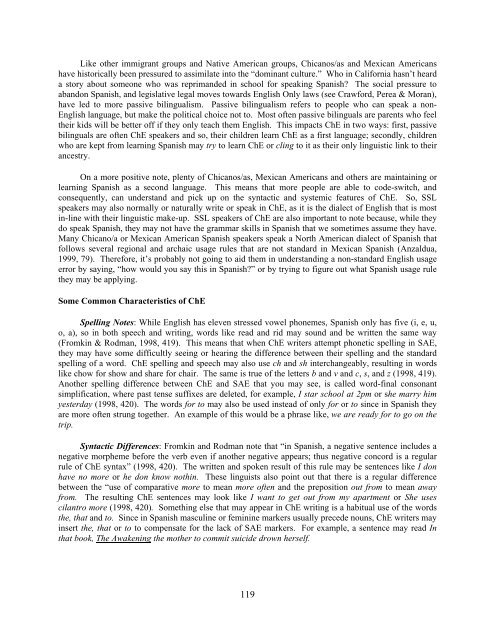The Tutoring Book - California State University, Sacramento
The Tutoring Book - California State University, Sacramento
The Tutoring Book - California State University, Sacramento
Create successful ePaper yourself
Turn your PDF publications into a flip-book with our unique Google optimized e-Paper software.
Like other immigrant groups and Native American groups, Chicanos/as and Mexican Americans<br />
have historically been pressured to assimilate into the “dominant culture.” Who in <strong>California</strong> hasn’t heard<br />
a story about someone who was reprimanded in school for speaking Spanish? <strong>The</strong> social pressure to<br />
abandon Spanish, and legislative legal moves towards English Only laws (see Crawford, Perea & Moran),<br />
have led to more passive bilingualism. Passive bilingualism refers to people who can speak a non-<br />
English language, but make the political choice not to. Most often passive bilinguals are parents who feel<br />
their kids will be better off if they only teach them English. This impacts ChE in two ways: first, passive<br />
bilinguals are often ChE speakers and so, their children learn ChE as a first language; secondly, children<br />
who are kept from learning Spanish may try to learn ChE or cling to it as their only linguistic link to their<br />
ancestry.<br />
On a more positive note, plenty of Chicanos/as, Mexican Americans and others are maintaining or<br />
learning Spanish as a second language. This means that more people are able to code-switch, and<br />
consequently, can understand and pick up on the syntactic and systemic features of ChE. So, SSL<br />
speakers may also normally or naturally write or speak in ChE, as it is the dialect of English that is most<br />
in-line with their linguistic make-up. SSL speakers of ChE are also important to note because, while they<br />
do speak Spanish, they may not have the grammar skills in Spanish that we sometimes assume they have.<br />
Many Chicano/a or Mexican American Spanish speakers speak a North American dialect of Spanish that<br />
follows several regional and archaic usage rules that are not standard in Mexican Spanish (Anzaldua,<br />
1999, 79). <strong>The</strong>refore, it’s probably not going to aid them in understanding a non-standard English usage<br />
error by saying, “how would you say this in Spanish?” or by trying to figure out what Spanish usage rule<br />
they may be applying.<br />
Some Common Characteristics of ChE<br />
Spelling Notes: While English has eleven stressed vowel phonemes, Spanish only has five (i, e, u,<br />
o, a), so in both speech and writing, words like read and rid may sound and be written the same way<br />
(Fromkin & Rodman, 1998, 419). This means that when ChE writers attempt phonetic spelling in SAE,<br />
they may have some difficultly seeing or hearing the difference between their spelling and the standard<br />
spelling of a word. ChE spelling and speech may also use ch and sh interchangeably, resulting in words<br />
like chow for show and share for chair. <strong>The</strong> same is true of the letters b and v and c, s, and z (1998, 419).<br />
Another spelling difference between ChE and SAE that you may see, is called word-final consonant<br />
simplification, where past tense suffixes are deleted, for example, I star school at 2pm or she marry him<br />
yesterday (1998, 420). <strong>The</strong> words for to may also be used instead of only for or to since in Spanish they<br />
are more often strung together. An example of this would be a phrase like, we are ready for to go on the<br />
trip.<br />
Syntactic Differences: Fromkin and Rodman note that “in Spanish, a negative sentence includes a<br />
negative morpheme before the verb even if another negative appears; thus negative concord is a regular<br />
rule of ChE syntax” (1998, 420). <strong>The</strong> written and spoken result of this rule may be sentences like I don<br />
have no more or he don know nothin. <strong>The</strong>se linguists also point out that there is a regular difference<br />
between the “use of comparative more to mean more often and the preposition out from to mean away<br />
from. <strong>The</strong> resulting ChE sentences may look like I want to get out from my apartment or She uses<br />
cilantro more (1998, 420). Something else that may appear in ChE writing is a habitual use of the words<br />
the, that and to. Since in Spanish masculine or feminine markers usually precede nouns, ChE writers may<br />
insert the, that or to to compensate for the lack of SAE markers. For example, a sentence may read In<br />
that book, <strong>The</strong> Awakening the mother to commit suicide drown herself.<br />
119

















